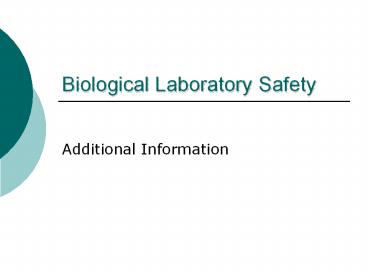Biological Laboratory Safety - PowerPoint PPT Presentation
1 / 14
Title:
Biological Laboratory Safety
Description:
Biological Laboratory Safety Additional Information Where to start Before looking at this presentation, ensure that you have watched the one on General Laboratory ... – PowerPoint PPT presentation
Number of Views:251
Avg rating:3.0/5.0
Title: Biological Laboratory Safety
1
Biological Laboratory Safety
- Additional Information
2
Where to start
- Before looking at this presentation, ensure that
you have watched the one on General Laboratory
Safety
3
What are the additional hazards from using
Biological Materials?
- Infectious agents
- Toxins
- Prions
- Bacteria
- Viruses
4
What legislation applies?
- The main pieces of legislation are
- Genetically Modified Organisms (Contained Use)
Regulations 2000 - Control of Substances Hazardous to Health Regs
2004 - Each will be summarised separately
5
Control of Substances Hazardous to Health Regs
2004
- Four Hazard Groups
- No hazard group 4 (highest risk) work in
Sheffield - Work on hazard group 3 requires special training
and Level 3 containment facilities - Risk assessments to be submitted to local LGMSC
for scrutiny for all GM work and work with
dangerous pathogens - Appropriate waste segregation required
6
Genetically Modified Organisms (Contained Use)
Regulations 2000
- All work to be risk assessed using the HSE risk
assessment form and be submitted to the Local
Genetic Modification Safety Committee before work
starts - Approval notification procedures
- Workers to submit health declarations to
Occupational Health - Appropriate waste segregation
7
Protective Clothing
- An appropriate laboratory coat must always be
worn, fastened up and covering all normal
clothing - Lab coats must be decontaminated before
laundering - Appropriate eye protection must be worn
- Gloves must be worn for work and must be removed
when handling taps, note books etc and before
leaving the laboratory
8
Blood bodily fluids
- Use screened animal blood, rather than human
blood if possible - Failing this use only screened human blood
- All blood and bodily fluids should be considered
potentially infectious and treated with due care - Injuries involving body fluids must be reported
to your supervisor IMMEDIATELY
9
Spillages
- Report
- Wear protective clothing
- Clean up
- Decontaminate ensure that you always have
material available to do so - Ensure waste is disposed of properly
- You spill you clean up!
10
Laminar Flow Cabinets
- Laminar flow cabinets are designed to provide a
clean-air environment to protect the work - They DO NOT provide protection for the operator
11
Biological Safety Cabinets
- Class 1
- Some protection to user environment
- No protection to work
- Class 2
- Good protection to user, the environment and the
work - Class 3
- Total enclosure
- You must choose the correct safety cabinet for
the job you are doing. Seek advice from your
Biological Safety Officer
12
Autoclaves
- Potentially dangerous equipment
- Require regular maintenance and an annual
statutory examination - Discard autoclaves must be calibrated every 6
months - You must be trained to use them
13
Disposal of Waste
- Make sure you follow the University policy
carefully - Ask your supervisor or a senior member of
technical staff if you do not know the correct
disposal method for the materials with which you
are working
14
When in doubt ASK!!!
- Do not carry out a new or unfamiliar procedure
until you have been fully trained understand
the precautions necessary for safe working - DO NOT GUESS!!!!

